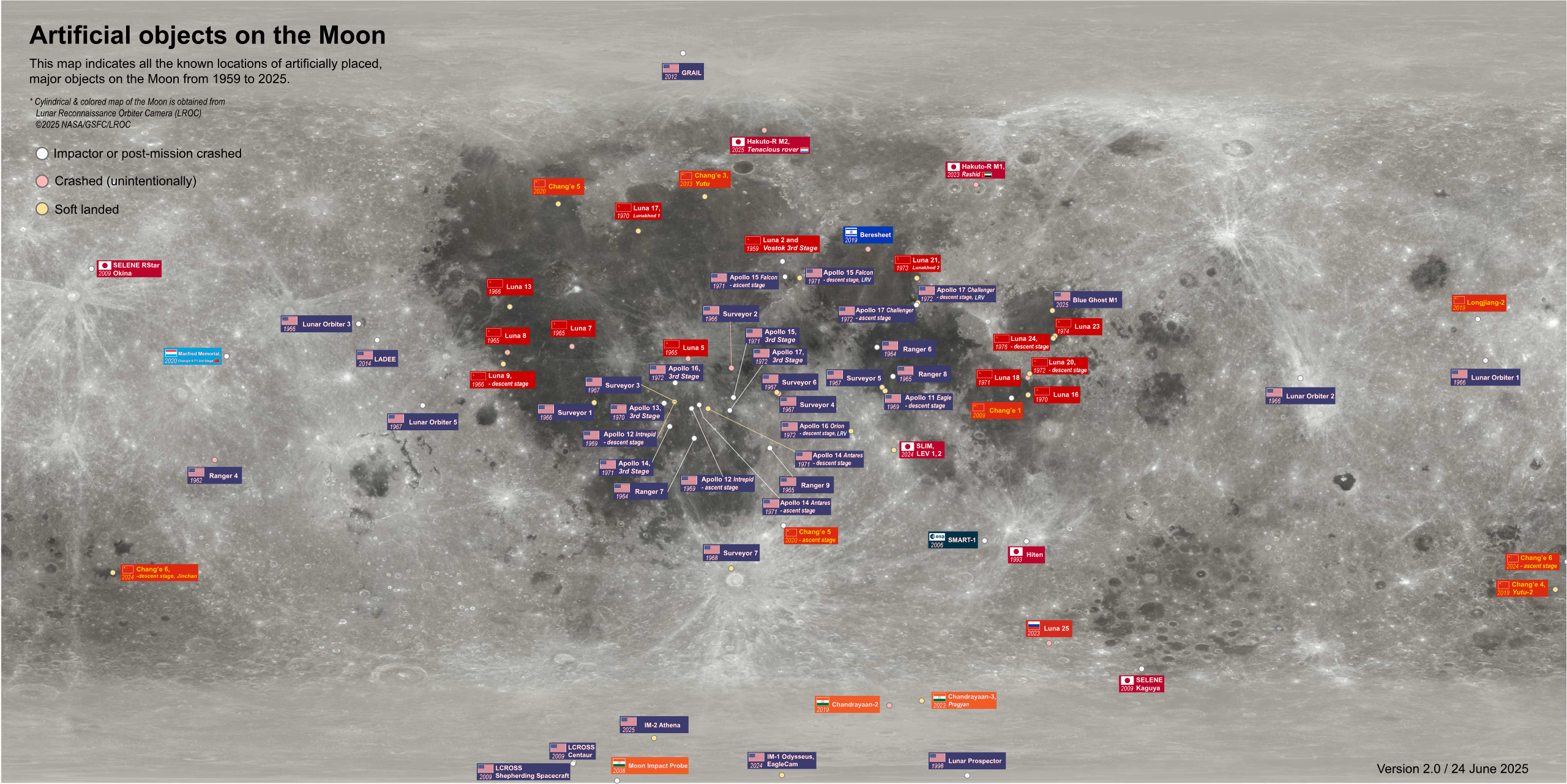Map of Artificial Objects on the Moon 1959 to 2025


Alex Cartwright
Senior Cartographer & GIS Specialist
Alex Cartwright is a renowned cartographer and geographic information systems specialist with over 15 years of experience in spatial analysis and data...
Geographic Analysis
What This Map Shows
The map titled "A map depicting all known locations of artificial objects on the Moon from 1959 to 2025" provides a detailed visualization of humanity's footprint on the lunar surface over more than six decades. This includes a variety of objects such as landers, rovers, satellites, and debris from various space missions. By pinpointing these locations, the map highlights not only the achievements of space exploration but also the significant historical and scientific events that have occurred on our celestial neighbor.
Deep Dive into Artificial Objects on the Moon
Ever wondered how many missions have actually touched down on the Moon? Since the first successful Soviet mission, Luna 2, impacted the Moon in 1959, human interest in lunar exploration has skyrocketed. Over the years, numerous countries have sent missions to explore the Moon, leading to a patchwork of artificial objects scattered across its surface.
As of 2025, there are over 60 known locations of artificial objects, ranging from the remnants of early landers like Luna 9, which transmitted the first images from the lunar surface, to modern explorations like NASA's Artemis program, aimed at establishing a sustainable human presence on the Moon. Each object has its own story, contributing to our understanding of the Moon’s geology, history, and potential for future exploration.
What's fascinating is the diversity of these missions. For example, the Apollo program, which ran from 1961 to 1972, placed not only astronauts on the Moon but also left behind equipment such as the Lunar Module Descent Stages and scientific instruments. These artifacts provide valuable insights into not only the technology of the time but also the scientific inquiries that drove these missions.
Moreover, the map captures the impact of international collaboration in lunar exploration. Countries like China and India have joined the ranks of lunar explorers, with missions such as China's Chang'e series and India's Chandrayaan missions contributing further to our understanding of the Moon. As we look ahead, it’s expected that additional missions will add to this map, with private companies and space agencies planning lunar landings and exploratory missions in the coming years.
Regional Analysis
When examining the map regionally, one can observe clusters of artificial objects concentrated in specific areas of the Moon, particularly in the regions known for their scientific interest. For instance, the Sea of Tranquility (Mare Tranquillitatis) is home to several Apollo landing sites, while the southern polar region has drawn the attention of missions like the recent Lunar Reconnaissance Orbiter due to its potential water ice deposits.
Interestingly, the distribution of these artifacts isn’t random. The locations often correlate with scientifically significant areas like the highlands and maria, where geological features can provide insights into the Moon's formation and history. For example, the Apollo 15 mission landed in the Hadley-Apennine region, known for its unique geological features, and left behind scientific instruments that are still being studied today.
Significance and Impact
Understanding the distribution of artificial objects on the Moon is crucial for several reasons. Firstly, it showcases humanity's ongoing quest to explore and understand celestial bodies beyond Earth. As we plan for future missions, including the potential colonization of the Moon, this map serves as a reminder of the legacy of previous explorations and the need for responsible stewardship of our lunar environment.
Moreover, the presence of these artifacts raises questions about space debris and its impact on future missions. As the Moon becomes a hub for exploration and possibly even habitation, addressing the issue of lunar debris will be essential. The map not only helps us keep track of what has been left behind but also encourages discussions about the sustainability of space exploration.
In conclusion, the map of artificial objects on the Moon from 1959 to 2025 is more than just a collection of points on a graphic; it encapsulates decades of human endeavor, scientific achievement, and the evolving relationship between our planet and its satellite. As we look to the future, this map will undoubtedly grow, and with it, our understanding of the Moon and our place in the universe will continue to expand.
Visualization Details
- Published
- October 23, 2025
- Views
- 14
Comments
Loading comments...